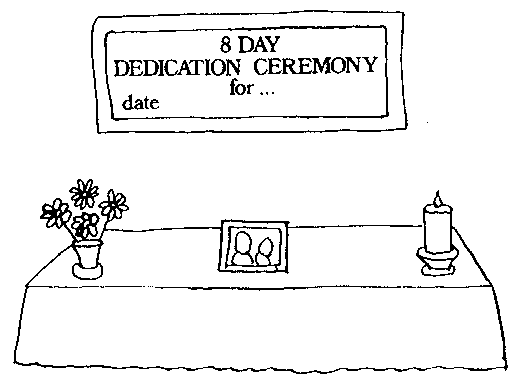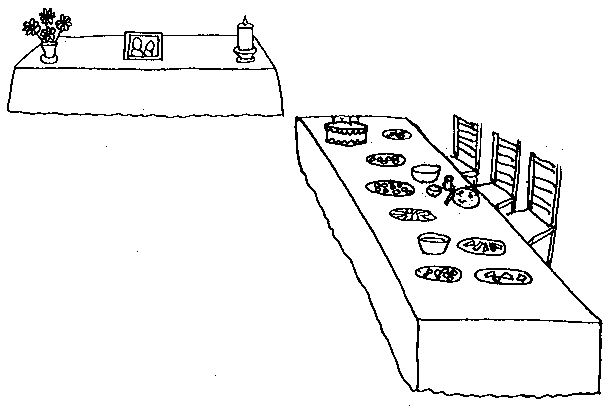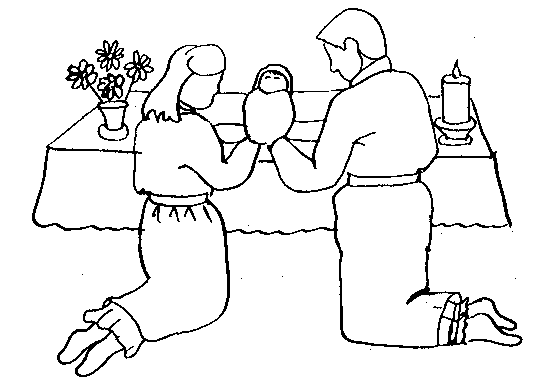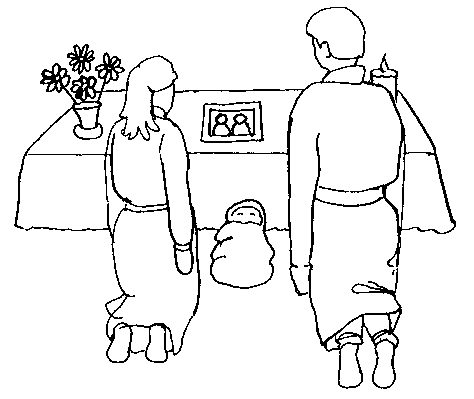Chapter 20
Eight Day Dedication Ceremony
Significance
The blessed couples of this age1 are not yet perfected; even though they conceive physical children, they cannot really embrace those children with true purity. Blessed couples should feel that they are entrusted as the care-givers for Heavenly Father's children, that He uses them to produce heavenly children, and that they assist Him in their nurturing and raising. Blessed children are the ideal of God. Therefore, blessed couples must be extremely grateful that Heavenly Father is able to depend on them to take care of heavenly sons and daughters.
Blessed couples express their gratitude during the traditional ceremony of offering the child to God, referred to as the Eight Day Dedication Ceremony. Because Heavenly Father utilizes blessed couples to conceive ideal life, we offer those children to become godly sons or daughters. Through this kind of ceremony, couples should determine to live the standard of the family tradition (the contents of The Pledge of the Families) and also promise to externally and internally take care of the child(ren) God gave them.
It is important to understand that the ceremony of child dedication is not concerned with externals, but rather is a truly internal ceremony. The main focus of the ceremony is the couple's gratitude to God.
After the national level foundation is restored and ideal families live in that environment, it will no longer be necessary to hold the Eight Day Dedication Ceremony.
Time of the Ceremony
Blessed couples should hold the child dedication ceremony on the morning (7:00 a.m. is the recommended time) of the eighth day after birth. Regardless of what time during the day or night the baby was born, that day should count as day number one. According to the Principle, the number eight signifies a new start.
Medical Complications
In the event of a premature birth, in which case the baby must stay in the hospital for several weeks or months. the parents should hold a small prayer service on the morning of the eighth day expressing their intention to hold a dedication ceremony when it becomes possible. In their prayer, the parents ask Heavenly Father for a time extension.
When the baby comes back from the hospital, the parents should choose a numerically significant day according to Principle and follow the guidelines and format described below.
In special cases (e.g., medical reasons) it is sometimes not possible to hold this ceremony exactly on the eighth day after birth. In such instances, another numerically significant day may be chosen for the ceremony, such as the twelfth or the sixteenth day. However, this is the exception rather than the rule.
In such cases, it is best to have the ceremony as soon after birth as possible, and it is advisable not to wait until the twenty-first or fortieth day.
Conducting the Ceremony
As the parents dedicate their child to God at the Eight Day Dedication Ceremony, it is not appropriate to ask an elder blessed couple to conduct the ceremony. The parents themselves should conduct the entire ceremony.
If One Parent Must Be Absent
If one of the parents must be absent, do not wait until both are present. Instead, the other parent should conduct the ceremony alone, representing the couple.
Attendance of the Ceremony
Particularly because the infant is so young, it is not a good idea to invite a large number of people to the Eight Day Dedication Ceremony. It is appropriate to invite members of one's Blessing trinity or a limited number of close friends into the ceremony itself.
Couples may wish to invite a number of additional guests for refreshments following the actual dedication prayer ceremony.
Grooming and Dress Code
Parents should bathe. Personal grooming should receive particular attention. The infant should also be bathed.
Husband and wife should dress in their white Holy Robes (refer to chapter 18, Holy Robes, for details).
Guests attending the ceremony should not wear Holy Robes.
Although it is preferable for the child to wear a ceremonial gown, it is not essential. If one cannot be obtained, it is acceptable to use white or light-colored new clothing.
Altar
It is best to keep the altar simple and focus on the child and the significance of the occasion.
Preparation
Purify the area for the ceremony by using Holy Salt (refer to chapter 8, Holy Salt: Uses of Holy Salt "Room or Areas," for procedure).
The altar or table should be prepared and placed toward the north. (If this is difficult, please refer to chapter 2, Prayer Rooms and Altars.) See diagram 20.1.
Required Articles
The couple may decide to place a white cloth (or sheet) on the floor just below the altar, although it is not essential.
The items necessary to place on the altar are: a white or light colored cloth (new if possible), a picture of the True Parents, and a minimum of one Birth Candle or one or two Shimjung Candles.

Figure 20-1
20.1. Banner and altar
A small vase of fresh flowers is an added touch but not essential.
Candles. If the parents choose to place a Shimjung Candle on the altar. it does not have to be a new one. It is not essential to use all seven Birth Candles on this altar. but all may be used if desired.
If only one Birth Candle or one Shimjung Candle is used. it should be placed toward the right side as one faces the altar. (Refer to diagram 20. 1.)
If two Shimjung Candles are used. they should be placed on either side of the True Parents picture.
It is not advised that the seed Birth or Shimjung Candle be used.
Seed candles should be reserved principally to multiply new candles.
Foods. It is not necessary to place bowls or baskets of fruits. nuts candies. etc.. on the altar. In the early times in Korea. couples generally could not afford to do this. It is acceptable. but it might be suggested that since this is not an actual offering table. refreshments be prepared and served to guests following the ceremony.
It is not appropriate to prepare a meal or cake for the Eight Day Dedication Ceremony altar.
Memorial Banner. Although it is not a mandatory practice. many parents elect to make a banner (see diagram 20.1 ) and hang it on the
wall above the altar. It may be kept and stored with the Birth Candles, if desired.
Gifts. On the occasion of the Eight Day Dedication Ceremony, parents should not prepare a gift for the child. This ceremony is basically held for Heavenly Father, not the child.
Ceremony Format
Internal Preparation
From the time the baby is born to the time of the Eight Day Dedication Ceremony, it is advised that the parents prepare internally for the ceremony through strong prayers of gratitude and determination.
Format
The following step-by-step guidelines are explained below: 1. Parents should face the altar 2. Light the candle(s) 3. Parents should hold the child in their arms 4. Silent prayer 5. Parents should kneel 6. Parents should raise the child (slightly) in offering 7. Place infant in front of altar (head pointing north) 8. Three full bows 9. Recitation of The Pledge of the Families 10. Recitation of My Pledge (if desired) 11. Representative prayer 12. Extinguish candles
Both parents should stand facing the altar. Either parent may light the candle(s). Both parents should then hold the child in their arms (diagram 20.2) and offer a (silent) prayer in preparation. At this time, they should cultivate a heart of offering, feeling that their child now belongs to God.
Both parents should kneel down and physically raise the child (slightly) in offering before God (diagram 20.3). The infant should then be placed on the floor in front of the altar (the head of the child should be pointing toward the north) (diagram 20.4).

Figure 20-2
20.2. Both parents hold child

Figure 20-3
20.3. Raise child (slightly) in offering

Figure 20-4
20.4. Place child on the floor in front of the altar
The couple should offer three full bows and recite The Pledge of the Families. (If desired, they may also recite My Pledge.) Either the husband or wife should offer a representative prayer (aloud) expressing to God that through this ceremony they dedicate this child to Him. (Refer to section below, "Significance of Representative Prayer.")
Closing the Ceremony. End the ceremony simply by extinguishing the candles (for traditional method, see chapter 15, Shimjung Candles: Extinguishing Candles).
Pictures may be taken if desired.
The guests may then be invited for refreshments if desired. The parents may wish to change clothing before joining their guests.
Guest Participation. Any guests attending this ceremony should not bow and should not recite either Pledge, but should join in heart with the parents at this precious occasion of offering their child.
Significance of Representative Prayer. The representative prayer is the parents' offering that this child become a godly son or daughter; they should ask that the child be accepted by God. They should share their determination to raise this child centering on God's will. The parents should pledge before Heavenly Father that they will take care of this child, internally and externally, and pray that he/she will inherit heavenly character and nature.
In the Case of Multiple Births
The same format should be followed in the event of multiple births. For example, each twin may be held by one of the parents; one triplet held by one parent and two held by the other parent, etc.
Note: For a brief explanation about 40-day or 100-day ceremonies, please see chapter 21, Blessed Family Ceremonies: Other Celebrations.
1
Ideal blessed couples (of the future) would not be considered in this category.